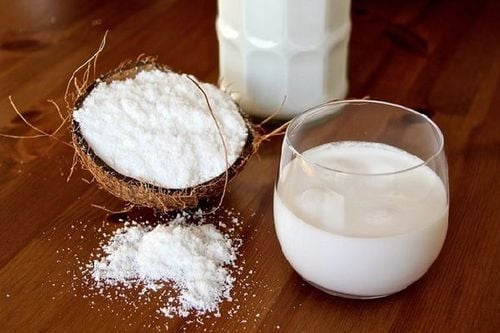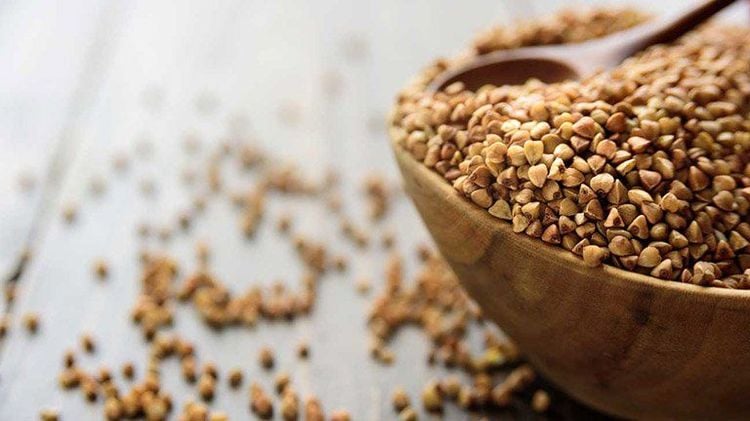This is an automatically translated article.
Flour is viewed as a food staple used to make desserts, pies, casseroles and pastas. However, some powders offer health benefits and others the opposite. As a result, many people are interested in replacing white flour with healthier options for baking and cooking. The article will list the 5 healthiest powders for health.
1. Coconut flour
Coconut flour - healthy flour belonging to the grain-free and gluten-free group of flours made by grinding dried coconut meat into a fine, soft powder. Coconut flour is higher in calories than traditional grain flours and is a good source of protein, fat, fiber and minerals like iron and potassium.
Unlike cereal flour, coconut flour contains a significant amount of fat. This fat is mostly saturated fat and is largely composed of medium-chain triglycerides (MCTs), which can reduce inflammation and support a healthy metabolism.
Although controversial, saturated fat from coconuts may affect your health differently than fast foods, fried foods and processed meats - and may even be beneficial.
Coconut flour is also rich in antioxidants and seems to have antibacterial properties. 64 grams provides:
Calories: 210 Protein: 8.5 grams Fat: 13 grams Carbs: 34 grams Fiber: 25 grams Iron: 22% of the Daily Value (DV) Potassium: 18% DV More, Coconut flour has a mild sweetness used to make cakes, cookies, breads and other baked goods.
Coconut flour tends to have a gritty texture and absorbs a lot of liquid, which can dry out some baked goods. Therefore, coconut flour works best in dishes that use eggs to maintain moisture and structure, such as muffins.
When substituting coconut flour for flour, use about 1/4 of the flour the recipe calls for, then replace the remaining 3/4 with another flour.
Also, since coconut flour requires more liquid than other flours, add 1 egg per 1/4 cup (32 grams) of coconut flour to the scones.

Bột dừa thuộc nhóm bột không có hạt và không chứa gluten
2. Almond powder
Almond flour is made by grinding blanched almonds into a fine powder. Since it contains no grains, it is naturally gluten-free. Almond flour is different from almond flour, which is a coarser ingredient made by grinding almonds with their shells still intact.
Almond powder provides magnesium, omega-3 unsaturated fats, vegetable protein and vitamin E - a powerful antioxidant. Remember that almonds, like other nuts and seeds, are high in calories.
The nutrients in this flour offer several benefits, such as improved insulin resistance, as well as lower LDL cholesterol and blood pressure. Almonds may also protect brain health, as vitamin E may reduce the risk of Alzheimer's disease.
56 grams of almond flour provides:
Calories: 340 Protein: 12 grams Fat: 30 grams Carbs: 12 grams Fiber: 4 grams Calcium: 5% DV Iron: 6% DV Potassium: 8% DV Magnesium: 65% DV Vitamin E: 100% DV Almond powder has a delicious taste and is very easy to use. In most recipes, you simply replace the almond flour with flour in equal proportions.
Almond flour works well in baked goods like pancakes, cookies, pies and cookies, along with some savory foods like homemade pasta and meatballs.
3. Quinoa flour
Quinoa flour is made by grinding quinoa to a fine powder. Gluten-free quinoa is considered by many to be a whole grain, which means it hasn't been processed and refined, leaving the original nutrients of the quinoa meal intact.
Quinoa provides protein, fiber, iron and unsaturated fats. Furthermore, it boasts antioxidant and anti-inflammatory effects that may benefit digestive health, inhibit tumor growth, and reduce overall disease risk.
56 grams of quinoa powder provides:
Calories: 200 Protein: 8 grams Fat: 2 grams Carbs: 38 grams Fiber: 6 grams Iron: 33% DV Potassium: 4% DV Humidifying, soft quinoa powder for pies. Replace it with half the amount of flour in most recipes.
Some people find this dough bitter, but you can lessen the aftertaste by baking the dough in a dry pan over medium heat for 5–10 minutes, stirring gently before adding to your recipe.
Quinoa dough is great for pancakes, muffins, pizza and pies. You can also use it to thicken soups and sauces.
4. Buckwheat flour
Buckwheat flour is made from ground buckwheat, a plant known for its seed-like seeds. Despite its name, buckwheat is not related to wheat and is therefore gluten-free.
Buckwheat flour has an earthy flavor and is used to make traditional Japanese soba noodles. It is a good source of fiber, protein and micronutrients such as manganese, magnesium, copper, iron and phosphorus.
Buckwheat flour may lower blood sugar in people with diabetes and improve biomarkers of heart health. Buckwheat flour may also have anti-cancer, anti-inflammatory, and prebiotic properties.
Prebiotics, a type of fiber that feed beneficial bacteria in your gut, support digestive system health.
60 grams of buckwheat flour provides:
Calories: 200 Protein: 4 grams Fat: 2 grams Carbs: 44 grams Fiber: 6 grams Iron: 17% DV Manganese: 34% DV Magnesium: 33% DV Copper: 73% DV Phosphorus: 17% DV For best results, buckwheat flour should be used in combination with other whole grain flours, making up 25–50% of the total flour in a recipe.
Buckwheat flour works well in pancakes and quick breads and makes a delicious crunchy coating for meats or other proteins.

Bột kiều mạch được làm từ kiều mạch xay
5. Whole wheat flour
Whole wheat flour and white flour are very different. While whole wheat is made by grinding the whole wheat kernel into a flour, white flour removes the most nutrient-dense parts - the bran and germ. Therefore, whole wheat flour is considered healthier.
Whole wheat flour provides protein, fiber and a variety of vitamins and minerals. Because wheat flour contains gluten, it is not suitable for people with celiac disease or gluten intolerance.
60 grams of whole wheat flour provides:
Calories: 200 Protein: 8 grams Fat: 0 grams Carbs: 42 grams Fiber: 8 grams Iron: 11% DV Potassium: 5% DV Whole wheat flour can used in equal amounts as white or all-purpose flour in any recipe. Keep in mind that it has a less cottony texture than white flour because it is unrefined.
You can enjoy it in homemade breads, muffins, cakes, cookies, rolls, pizza dough, pancakes and waffles.
Today healthy powders are more widely available than ever. Traditional flours are made from wheat, but many other flours are made with naturally gluten-free nuts and grains, such as coconut, quinoa, almonds, and buckwheat. Each offers a unique flavor and nutritional profile. You can experiment with different flours to find the one that works best for your recipe. Their ratios are not interchangeable, so be sure to look up the conversion when you're baking.
Please dial HOTLINE for more information or register for an appointment HERE. Download MyVinmec app to make appointments faster and to manage your bookings easily.
Reference source: healthline.com







